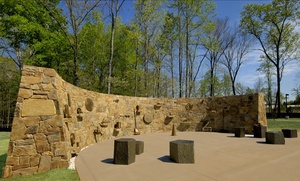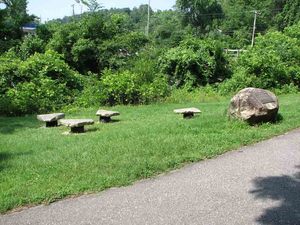
Photo: Chapel Hill Public & Cultural Arts Office
A public art program can not only contribute to the visual character of a community but also serve as an engine for economic development, according to Jeffrey York, head of the Public & Cultural Arts Division within the Chapel Hill Department of Parks & Recreation. York spoke recently to the Carolina Meadows group on Antiques and Collectibles.
York cites Laurie Paolicelli, director of the Orange County Visitors Bureau, who touts Chapel Hill’s public arts program as a factor in attracting visitors to the community. In fact, for four years running, Chapel Hill has been named one of the top 25 small town arts destinations by American Style Magazine. With a world-class museum and performing arts on campus and more artists in Orange County than elsewhere in the state, Chapel Hill is beginning to look like an arts mecca through public art.

More than 200 communities across the U.S., including Chapel Hill (since 2003) allocate 1 percent of civic project costs to art by reallocating already-approved expenditures for specific civic improvement project dollars. These funds can be considered an expenditure for a community’s cultural infrastructure.
York said when artists become involved in helping to design our built environment, empty plazas, boring intersections, box-like commercial buildings and other bits of mundane urban infrastructure can become exciting and add to the identity of a community. He illustrated several examples of poorly designed spaces and those same spaces that included public art. The contrast was stark and showed graphically just how much individual identity a community can create with imagination and the necessary funds.
Some of the examples were inventive artist-designed utilitarian amenities like park benches and bus shelters, while others depicted elegant fountains, monuments and statuary, curved sidewalks with inlaid mosaic tiles, street intersections adorned with creative lighting, and elaborate displays of flower-filled round-abouts, plus colorful murals adorning the walls of buildings.

He suggested that public art not only helps to lend identity to a community but provides visual appeal both for its citizens and tourists, and adds to the safety of the areas. He added that shopping malls and businesses can literally lead customers into their places with appealing designs including the layout of parking lots in something other than rectangular squares.
Chapel Hill is extremely environmentally conscious, so most of the projects supported by One Percent for Arts funds in Chapel Hill are what York called “green art.” He cited several examples, such as the area along the Bolin and Morgan Creek greenway trails where some 18 benches, bike racks, trail markers, and a gate are all made from used Chapel Hill transit bus brake drums and recycled concrete and stainless steel.
At Southern Community Park there are eight environmental installations, all fashioned from boulders, trees and other organic materials found on the site. Last year an artist created a low bamboo fence that follows the contours of of the terrain and prevents erosion from storm water run-off near Town Hall. Such works have won national recognition from the Americans for the Arts and Landscape Architecture Magazine.
Not all artworks created through the program are “green,” he said. “A beautiful terrazzo floor embedded with over 2000 glass rods at the Aquatic Center enhances the foyer of the center.
Other programs of the Office of Public & Cultural Arts “bring artists into the schools and underserved communities, offer artists opportunities to exhibit their work in Town Hall and the Library, and celebrate the community’s creativity.” York also works with private developers to incorporate public art into their developments, and he predicted that the next couple of years will see some very exciting projects emerge.
By Clarence Whitefield
